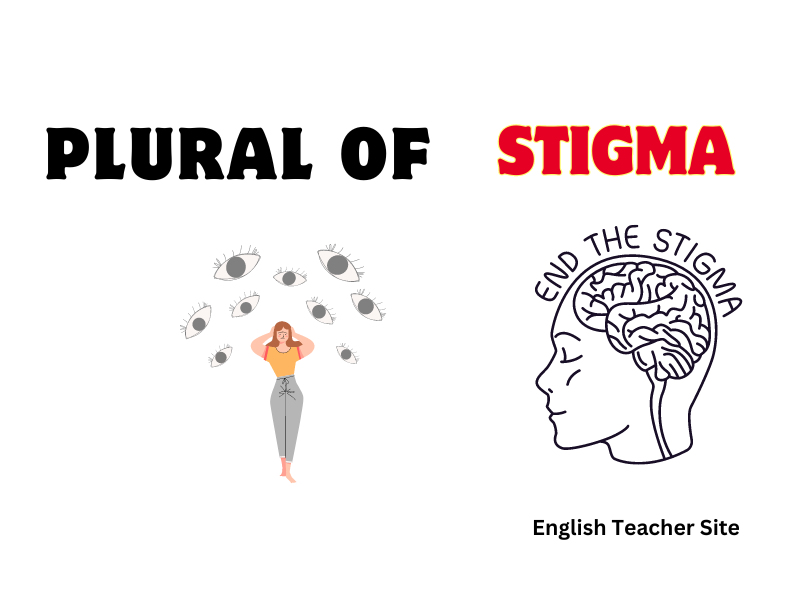What’s the Plural of Stigma? Understanding Variations in English NounsStigmaWhat’s the Plural of Stigma? Understanding Variations in English Nouns

- “Stigma” can pluralize to “stigmas” for general use or “stigmata” in specific, often historical or religious, contexts.
- The choice between “stigmas” and “stigmata” often hinges on the formality of the language and the traditional uses.
- Clarity and adherence to the appropriate context are crucial when choosing the correct plural form of “stigma.”
“Stigma” follows a more classical pattern of transformation. The original Greek term carried over into Latin, and eventually into English, has bestowed upon it two accepted plural forms: “stigmas” and “stigmata.” The prevalence of one form over the other often depends on the context in which the word is used, and both are correct depending on the circumstances.
What’s the Plural of Stigma?
Plural Forms of Stigma:
- Stigmas: This plural form follows the standard English pattern of adding an ‘s’ or ‘es’ to a noun to make it plural. It is widely used in everyday language and is appropriate when discussing the social or symbolic ‘marks’ that individuals or groups may bear.
- Stigmata: This is the less commonly used plural form which preserves the original Latin pluralization of the word. ‘Stigmata’ specifically refers to the marks corresponding to the wounds on the crucified body of Jesus Christ, often reported to appear miraculously on the bodies of saints and mystics.
| Usage Context | Appropriate Plural |
|---|---|
| Medical or social contexts | Stigmas |
| Religious or mystical phenomena | Stigmata |
Examples in Sentences:
- The stigmas associated with mental health can prevent people from seeking help.
- Stories of holy figures bearing the stigmata have persisted throughout history.
Pluralization in English:
English nouns are typically made plural with the addition of -s or -es. However, some words like ‘stigma’ retain alternative plurals from their languages of origin.
| Standard Pluralization | Alternative Pluralization |
|---|---|
| Add -s or -es | Retain original form |
Determining Singular or Plural for Stigma
The singular form is stigma, which refers to a mark or a symbol associated with negative perception. When it comes to pluralizing stigma, we encounter two acceptable forms based on its etymological roots.
| Singular Form | Meaning |
|---|---|
| Stigma | A mark of disgrace or infamy; a specific diagnostic sign of a disease |
| Traditional Plural Form |
|---|
| Stigmata |
- Stigmata
- The community believed that the marks were stigmata, symbolizing a deeper religious experience.
- Stigmas
- The patient’s visible symptoms were accompanied by stigmas due to societal ignorance.
The use of stigmas is more prevalent in the contexts of sociology, psychology, and medicine, whereas stigmata often surfaces within religious, historical, or cultural discussions.
Dictionary Definition of a Stigma
A stigma, in the societal context, pertains to a mark of disgrace or a negative stereotype that sets a person or a group apart from others. The term often bears a significant weight, as it involves the collective behavior and beliefs of a community or society towards particular characteristics or identities, which are deemed less favorable.
Merriam-Webster defines ‘stigma’ as:
- A mark of shame or discredit : Stain
- e.g., stigma attached to mental health
- An identifying mark or characteristic : Specifically, a specific diagnostic sign of a disease
The Cambridge Dictionary elaborates on this definition with:
Stigma (Noun)
- A strong feeling of disapproval that most people in a society have about something, especially when this is unfair.
Forms of Stigma
The word ‘stigma’ in its plural form can be expressed as ‘stigmas’ or ‘stigmata’. The choice of pluralization can reflect different contexts:
| Singular | Plural – Common | Plural – Formal |
|---|---|---|
| stigma | stigmas (general contexts) | stigmata (specifically in biology) |
Examples in Society
In consideration of how stigmas manifest in everyday life, here are some contexts where the term could apply:
- Social Stigma: Resulting from societal attitudes towards certain conditions or behaviors.
- e.g., unemployment, divorce
- Self-Stigma: When individuals internalize these negative stereotypes.
- e.g., A person feeling shame due to chronic illness
Greek Nouns:
Singular to Plural:
When converting Greek nouns from singular to plural, one must look at the ending of the singular form. Generally, masculine and feminine nouns ending in -ας, -ης, or -ος often change to -οι or -αι in the plural. On the other hand, neuter nouns ending in -ον typically change to -α in the plural.
Classical Influence:
The classical form of Greek nouns continues to impact the modern usage. Some nouns retain their ancient plural forms, which can seem irregular. The word ‘stigma’ is a prime example. It derives from the Greek word ‘στίγμα’ (stígma).
Declension of Nouns:
The following tables outline the changes in noun endings from singular to plural for the three Greek genders:
Masculine:
| Singular Ending | Plural Ending | Example |
|---|---|---|
| -ας | -αι | ποιητής |
| -ης | -εις | ναύτης |
| -ος | -οι | λόγος |
Feminine:
| Singular Ending | Plural Ending | Example |
|---|---|---|
| -α | -αι | ώρα |
| -η | -ες | νύμφη |
Neuter:
| Singular Ending | Plural Ending | Example |
|---|---|---|
| -ον | -α | δένδρον |
| -μα | -ματα | πρόβλημα |
Examples in Modern Language:
- A common noun like ‘στίγμα’ (stigma) reflects the transition from ancient to contemporary Greek. In its plural form, it becomes either ‘στίγματα’ (stigmata) or ‘stigmas’.
- In religious contexts, ‘stigmata’ specifically denotes the marks resembling the wounds of Christ.
Contextual Examples of Stigma
Sociology and Psychology
| Singular Use | Plural Use |
|---|---|
| A stigma surrounds individuals dealing with mental health issues. | Several stigmas are attached to various mental health disorders. |
In sociology and psychology, stigmas fundamentally relate to shared attitudes that contribute to ostracizing individuals or groups. For example:
- Stigma in a workplace can prevent open discussions about mental health.
- Stigmas in society create barriers for people seeking support or understanding.
Medicine
In a medical context, stigma refers to a physical manifestation indicating the presence of a disease or condition.
| Medical Use (Singular) | Medical Use (Plural) |
|---|---|
| The rash was a stigma of the underlying illness. | The patient exhibited multiple stigmas revealing a complex medical history. |
- A singular stigma may be a symptomatic indicator on the skin.
- Stigmas or stigmata are discernible signs that clinicians assess during diagnosis.
Culture and Identity
Stigma can be found in discussions of culture and identity, often highlighting marginalized or misunderstood segments of the populace.
- The artist faced a stigma for her provocative work.
- Immigrants may confront various stigmas stemming from cultural differences.
Contextual Examples of Stigmas/Stigmata
In a social context, stigmas may suggest aspects such as:
- A record of crime causing a stigma to employment opportunities.
- Mental health challenges facing societal stigma.
For historical and religious references, stigmata is primarily used:
- Reports of individuals exhibiting the signs of Christ’s crucifixion wounds.
The following tables provide clear examples:
Table 1: Social Stigmas
| Quality/Condition | Contextual Example of Stigma |
|---|---|
| Crime | Having a criminal record can create a stigma that affects one’s job prospects. |
| Mental Health | Mental illnesses can lead to stigma deterring people from seeking help. |
Table 2: Religious Stigmata
| Religious Context | Description of Stigmata |
|---|---|
| Catholic Mysticism | Individuals receiving stigmata are believed to bear the physical marks resembling the wounds of Jesus Christ. |
- Addiction carries a stigma leading to social isolation.
- Bankruptcy often results in a financial stigma affecting future creditworthiness.
- People living with HIV/AIDS combat significant social stigma.
- St. Francis of Assisi was one of the first recorded cases of stigmata.
- Many with stigmata claim to share in the physical suffering of Christ.
Origin of the Word Stigma
The term stigma has its roots deeply embedded in ancient languages. Initially, the Greek word stizein, meaning “to tattoo”, provided the base for what would evolve into the concept of stigma. This etymological descendant referred to a physical mark or brand, often used to identify and stigmatize individuals in society.
Greek Foundations:
| Greek Word | Meaning |
|---|---|
| Stizein | “To tattoo” or “mark” |
In essence, these early marks were created with a puncturing technique that left an indelible sign on the skin, akin to modern tattooing practices. From here, stigma journeyed through linguistic transformations.
From Greek to English:
- Stigma in Ancient Greek: A mark or tattoo
- Stigmatos: The term used to denote the plural form
The Latin language adopted the word with little alteration, keeping its original implications and pronunciation intact. As the term entered the Old English lexicon through the Latin influence, its connotations expanded to include both physical and metaphorical marks.
Transition to English:
| Latin to English | Meaning |
|---|---|
| Stigma | “Mark”, “point”, or “brand”, both in the literal and figurative sense |
The transformation of stigma in English broadened, signifying not just a tangible mark but also a symbol of disgrace or infamy. Over time, the plural form stigmata took hold when referencing multiple instances or markings, true to its Latin and Greek origins.
Plural Variations:
- Stigmas: Often used in contemporary English
- Stigmata: Retains the classical plurality from Latin and Greek
Sources
Harper, Douglas. “Etymology of stigma.” Online Etymology Dictionary.
My name is Khamis Maiouf. I am the creator of the English Teacher Site, dedicated to providing valuable resources and insights for students around the world. With a passion for education and a commitment to helping students enhance their skills, I aim to make English teaching more effective and enjoyable for both educators and students.





